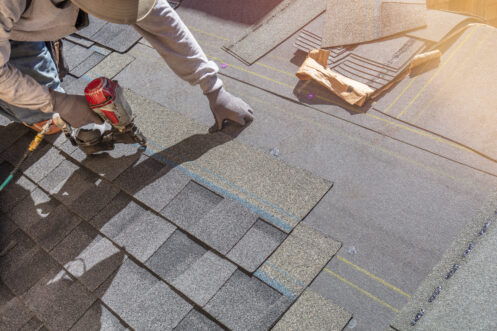When your roof absorbs heat all day, that warmth doesn’t stop at the shingles. It travels into your attic, stresses your ventilation, and makes your AC work harder than it should. High rooftop temperatures can even wear down roofing materials faster than expected. With a few smart upgrades or habits, you can help cool things down from the top.
Reflective Roofing Materials Do More Than Look Bright
Some roofs absorb sunlight like a sponge. Dark shingles pull in heat and keep it trapped, raising the temperature of your attic and everything below it. When your home is baking from the top, your air conditioning works longer to cool the same space. That adds to your energy bill and puts extra wear on your system. If you’ve ever touched a dark roof in the summer, you’ve felt just how hot it can get. The surface can climb well over 150 degrees Fahrenheit by mid-afternoon. That heat doesn’t stay on the roof. It pushes down into your attic space.
Reflective roofing helps with that problem. Lighter-colored shingles or specially coated materials bounce sunlight back instead of absorbing it. Some are made with granules that reflect infrared light. Others use coatings that act like a mirror to reduce surface heat. Roofs built with reflective materials stay cooler, even on triple-digit days. That change can keep your attic 20 to 30 degrees lower, carrying through to your living space.
Ventilation Keeps Heat From Building Up
You can have the best roofing material in the world, but if the heat can’t escape, it collects under the surface. Without ventilation, the attic becomes an oven. As hot air rises and stays stuck under the roof deck, it warps the plywood, dries out insulation, and speeds up the breakdown of sealants. In the worst cases, it can damage electrical components or roof-mounted HVAC units.
Ventilation allows that trapped heat to exit naturally. Ridge vents along the top of your roof work with soffit vents under the eaves to pull cooler air in and push hot air out. This flow doesn’t require fans or fancy upgrades. It just needs a clear path for the air to move. If your attic smells musty or feels hotter than expected, even at night, the airflow might not be working like it should. You might have blocked vents, a missing intake, or poor circulation. Fixing the flow can protect your roof and lower your cooling load during the hottest part of the year.
Radiant Barriers Stop Heat Before It Reaches Your Insulation
Most of the heat that enters your home through the roof comes from radiant energy. That’s the same kind of heat you feel when you walk past an open oven. It moves directly from the roof surface into the attic, where it strikes insulation and reflects around the space. Insulation helps slow it down, but by the time it reaches your ceiling, the heat has already started to enter your living space.
A radiant barrier gives that heat a surface to bounce off instead of passing through. These barriers usually come in the form of foil-faced sheets or reflective spray coatings applied to the underside of your roof deck. They reflect the heat back toward the outside before it reaches your attic floor. In homes with dark shingles or south-facing roof slopes, radiant barriers can make a significant difference in attic temperature. When installed correctly, they cut down the load on your insulation and give your home more consistent comfort without extra cooling.
Cool Roof Coatings Can Refresh Old Surfaces Without Replacing Them
If your roof isn’t due for replacing but still absorbs a lot of heat, there are ways to improve its performance without tearing it off. Cool roof coatings come in liquid form and are applied to the surface like paint. They create a reflective layer that bonds with the material underneath and work on metal roofs, flat roofing systems, and some asphalt-based products. Once cured, they reflect sunlight better than the original surface and help reduce roof temperature.
Attic Insulation Adds Resistance Where Heat Slips In
Your attic works as a buffer zone between your roof and your living space. But without enough insulation, that buffer starts to collapse. Heat that moves through the roof enters your attic and immediately begins heating the air above your ceiling. The thinner that layer, the faster your indoor temperature rises. Insulation acts as a barrier to slow that movement. If your attic has gaps, compressed insulation, or low coverage, the roof’s heat will creep in no matter what material you use outside.
Summer is a good time to check for insulation problems. You can often tell something’s off if your upper rooms stay warm while the rest of the house feels cool. Look for uneven temperatures, high electric bills, or hot ceiling spots. Blown-in insulation or batt products can be added without starting from scratch. A quick measurement of your attic depth might show you exactly where more coverage could help.
Landscaping and Shade Can Take Pressure Off the Roof
Not all cooling strategies start on the roof itself. Sometimes the space around your home offers the most useful changes. Trees that provide shade over parts of your roof reduce how much sunlight reaches the surface. That shade lowers the roof temperature and slows down radiant heat transfer. If you’ve got sections of the house that stay cooler in the afternoon, check to see if they sit beneath tree cover.
You don’t have to plant giant trees to help. Pergolas, shade sails, and even carefully placed trellises can break up the direct sunlight and reduce surface heat. Just make sure any nearby branches don’t rest against the shingles. Too much contact can trap moisture or cause damage during storms. When done thoughtfully, exterior shade doesn’t just help your windows. It cuts down the temperature across your roof and gives your attic more time to recover after a hot day.
Light-Colored Roofing Reflects More Than Heat
When you think about roof color, you might focus on curb appeal. But color also plays a part in how your roof interacts with the sun. Dark roofs hold more heat, while light-colored shingles or panels reflect more sunlight back into the atmosphere. If your area sees frequent high temperatures, choosing a lighter roofing option can change how your attic handles heat.
Modern roofing products offer more variety now, so you’re not stuck with plain white or light gray. Many manufacturers produce lighter versions of common colors like brown, blue, or green, designed to reflect more heat while still matching traditional home styles. If you’re replacing your roof and looking for ways to keep the house cooler, color should be part of the conversation. It’s one of the simplest ways to get passive cooling without installing anything extra.
Stay Cool This Summer Through Your Roof
At Fraser Roofing, LLC, in Atlanta, GA, we help homeowners find roofing solutions that match their home and climate. We also offer attic ventilation upgrades, roof repairs, radiant barrier installations, and roof coating services. If you’re ready to look at options that actually make a difference, contact Fraser Roofing, LLC today.

